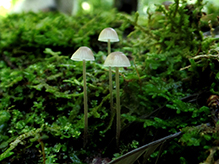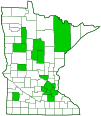Blue Mycena
(Mycena subcaerulea)
Conservation • Description • Habitat • Ecology • Distribution • Taxonomy
Conservation Status |
|
|||||||
| IUCN Red List | not listed |
|||||||
| NatureServe | NNR - Unranked |
|||||||
| Minnesota | not listed |
|||||||
Description |
||
Mycena is a large genus of small mushrooms. There are almost 600 Mycena species worldwide. Eight bluish species have been documented so far. Two of these have been reported in North America. Blue Mycena is a common, small, cool season, gilled mushroom. It occurs in the United States from Maine to northern Georgia, west to Minnesota and Missouri. It is not uncommon in Minnesota. It appears in the cool spring, disappears in the warm summer, and returns in the cool fall. It is found alone, scattered, or in groups but not clustered (gregarious), in deciduous and mixed forests and woodlands. It grows on the well-rotted wood, woody debris, and dead leaves of hardwoods, especially oaks but also basswood, elm, and beech. It sometimes grows on bark around the base of live trees. It obtains its nutrients from dead wood (saprobic). When it first appears, the cap is blue or greenish-blue and more or less egg shaped, with the margins curved inward. It soon turns brown in the center with blue tinting at the margin. As it ages, the cap spreads out and usually loses all hints of blue coloration. Mature caps are broadly cone shaped to bell shaped and are usually 3⁄16″ to ⅝″ (5 to 15 mm) in diameter, rarely up to 1″ (25 mm) in diameter. They are brown to grayish brown in the center with a pale margin. The surface is hairless and moist or sticky. There is sometimes a grainy dusting near the margin. The margins are usually grooved (striate) and are translucent when moist. Sometimes blue tinting is retained on the margin. On older specimens the margin is often yellowish. The gills are narrow to moderately broad and are closely spaced to crowded. There are 18 to 25 main gills that extend from the margin to the stalk, and between the main gills there are two or three series of short gills that do not reach the stalk. The main gills curve upward approaching the stalk. They may be broadly attached or narrowly attached to the stalk, or almost unattached (free). The gills are white, sometimes tinged with gray. The edges are sometimes fringed. The stalk is fragile, hollow, 1¼″ to 3⅛″ (3 to 8 cm) long, and 1⁄32″ to 1⁄16″ (1 to 2 mm) thick, equal in size from top to bottom. When young, it is bluish near the top and fuzzy, covered with fine hairs from top to bottom. As it ages it turns first grayish then finally brownish. The vegetative portion at the base (mycelium) is blue at first but soon fades to white. The flesh is thin and pale. Some sources maintain that it is edible. However, it is insubstantial, and it may contain the toxin muscarine, so eating is not recommended. The spore print is white. |
||
Similar Species |
||
Bluefoot Bonnet (Mycena amicta) is the only other Mycena species that has a bluish tint when young and occurs in North America. It is found in late summer to late fall, rarely in spring. It grows on the dead wood of conifers. There is a single record of it from Minnesota, but that is far outside of its known range. |
||
Habitat and Hosts |
||
Deciduous and mixed forests and woodlands |
||
Ecology |
||
Season |
||
Spring, summer, and fall |
||
Distribution |
||||
|
Sources |
|||
| 11/30/2023 | ||||
Occurrence |
||||
Not uncommon |
||||
Taxonomy |
|||
| Kingdom | Fungi (Fungi) | ||
| Subkingdom | Dikarya | ||
| Phylum | Basidiomycota (Basidiomycete Fungi) | ||
| Subphylum | Agaricomycotina (Higher Basidiomycetes) | ||
| Class | Agaricomycetes (Mushrooms, Bracket Fungi, Puffballs, and Allies) | ||
| Subclass | Agaricomycetidae | ||
| Order | Agaricales (Common Gilled Mushrooms and Allies) | ||
| Suborder | Marasmiineae | ||
Family |
Mycenaceae | ||
Genus |
Mycena (bonnets) | ||
| Section | Viscipelles | ||
| Complex | Mycena amicta | ||
Synonyms |
|||
Agaricus subcoeruleus |
|||
Common Names |
|||
Blue Mycena |
|||
Glossary
Mycelium
The vegetative part of a fungus; consisting of a mass of branching, thread-like hyphae, through which a fungus absorbs nutrients from its environment; and excluding the fruiting, reproductive structure.
Saprobic
A term often used for saprotrophic fungi. Referring to fungi that obtain their nutrients from decayed organic matter.
Striate
Striped or grooved in parallel lines (striae).
Visitor Photos |
|||||
Share your photo of this fungus. |
|||||
| This button not working for you? Simply email us at info@MinnesotaSeasons.com. Attach one or more photos and, if you like, a caption. |
|||||
Luciearl |
|||||
 |
|||||
MinnesotaSeasons.com Photos |
|||||
|
|||||

Slideshows |
||

Visitor Videos |
|||
Share your video of this fungus. |
|||
| This button not working for you? Simply email us at info@MinnesotaSeasons.com. Attach a video, a YouTube link, or a cloud storage link. |
|||
Other Videos |
|||

Created: 11/30/2023
Last Updated:


